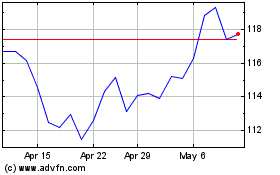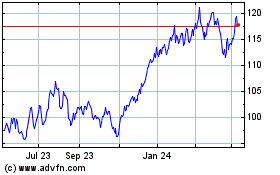Australia's Economic Growth Accelerates on Strong Exports
01 June 2016 - 5:40PM
Dow Jones News
SYDNEY—Australia's economy grew at its fastest pace in 3½ years
in the first quarter, outpacing other advanced economies even as it
added more uncertainty to the outlook for interest rates.
Gross domestic product grew 1.1% in the first quarter from the
fourth quarter and 3.1% from a year earlier, a government report
showed Wednesday. Economists surveyed by The Wall Street Journal
had expected 0.9% growth from the previous quarter and a 3.0%
year-over-year rise.
With a month to go before a federal election, Treasurer Scott
Morrison embraced the news, saying the data confirm that a
transition in the economy away from mining was evident.
"[Australia's growth is] faster than the United Kingdom, the
United States, the eurozone. It's more than twice the growth we're
seeing in Canada, faster than Singapore, faster than New Zealand
and now even faster than South Korea," he said.
Economists say higher export volumes of iron and liquefied
natural gas are supporting growth, helping to offset lower
commodities prices as a decadelong mining boom comes to an end.
"The mining investment boom is paying dividends and the lower
Australian dollar is boosting services, thereby fostering a
rebalancing of the Australian economy," said Andrew Hanlan, a
senior economist at Westpac.
In addition, unemployment has fallen to a 2½ -year low, helping
to lift consumer spending.
Michael Canturi, 35, the owner of Dahlias Cafe, an eatery in
Campbelltown, a suburb on the outskirts of Sydney, said he invested
300,000 Australian dollars (US$216,960) recently to expand his
small business.
But not all retailers are experiencing the same growth, Mr.
Canturi said, though those in hospitality tend to do better as more
consumers find room in their budgets to eat out.
Australia is also experiencing strong residential housing
construction, led by a boom in apartments, while a lower Australian
dollar is lifting services exports, leading to strong growth in
industries like tourism, health care and education.
Still, falling mining investment is likely to be a drag on
growth for the next year at least, economists say.
Some economists say that the stellar growth is based mostly on
exports, leaving the country exposed to global shocks, while income
growth has been constrained as commodities prices remain weak.
Gareth Aird, an economist at the Commonwealth Bank, said the
circumstances now facing the economy, which include surging growth
and the slowest pace of wage growth in 30 years, were
"bizarre."
The Reserve Bank of Australia cut interest rates on May 3 to a
record low of 1.75% after the economy slid into deflation in the
first quarter. Economists had widely forecast further cuts before
the GDP report; some continue to expect more cuts over the next
year.
The Australian dollar rallied after the release of the
economic-growth data, as bets on a further interest-rate cut were
pushed back into next year.
Jasmin Argyrou, a senior-investment manager at Aberdeen Asset
Management, said there was a growing disconnect between Australia's
economic activity and inflation, which remains below the central
bank's comfort level.
"Against this solid economic backdrop, monetary easing will be
very gradual and it could be a long time between cash rate cuts,"
she said.
Write to James Glynn at james.glynn@wsj.com
(END) Dow Jones Newswires
June 01, 2016 03:25 ET (07:25 GMT)
Copyright (c) 2016 Dow Jones & Company, Inc.
Commonwealth Bank Of Aus... (ASX:CBA)
Historical Stock Chart
From Mar 2024 to Apr 2024

Commonwealth Bank Of Aus... (ASX:CBA)
Historical Stock Chart
From Apr 2023 to Apr 2024
